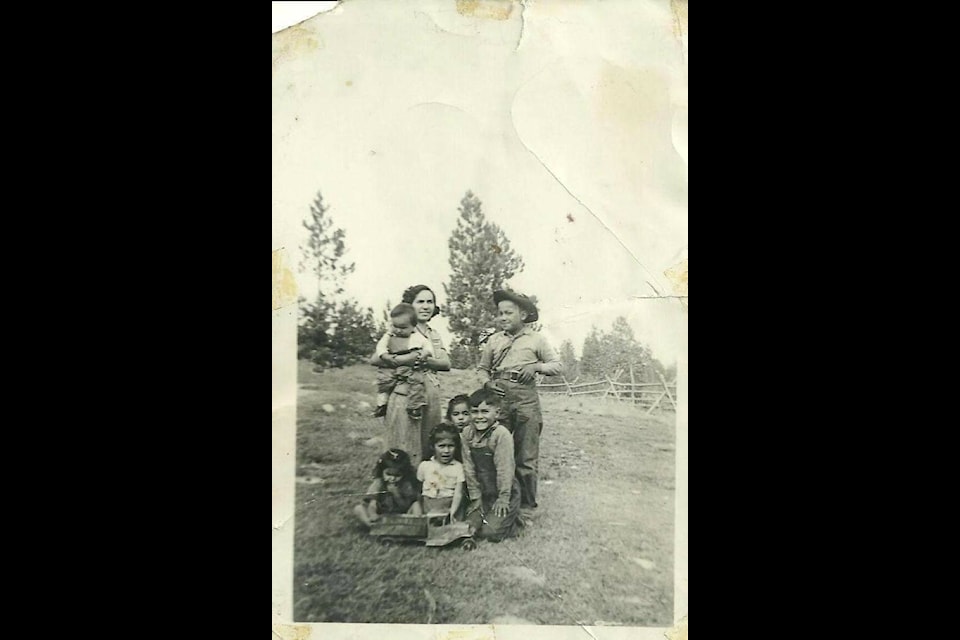By Kelly Sinoski
Lenora Fletcher grew up without her First Nations status.
She wasn’t the only one. When her grandpa died, her granny Celestine Fletcher inadvertently signed away the status for her entire family, including her own 10 children and their descendants.
“In the long run our family believes that was a benefit to our family,” Lenora says. “They didn’t have to go to residential school, they didn’t have to go through those traumas.”
But her granny’s decision, marked with a simple X on a government form, would have an effect in other ways. Lenora says the Llenlleney’ten (High Bar) First Nation, once 5,000-member strong, had already seen a decline in its population, due in part to those who weren’t counted in the government check-points. Most died of smallpox. Still others migrated to other bands, through marriage or family connections.
For years, the population hovered around 100. By the 1970s, their numbers had dwindled to as low as six registered members.
“We just about died out,” says Yvonne Smith, the senior ambassador for the band. “We are definitely fighting our way back with all the barriers in front of us.”
Today, the band is growing, with about 200 members as people like Lenora get their status in adulthood, and more young people have babies. But with a reserve on steep, dry land with a lack of water and nowhere to build homes, its people remain scattered across B.C. and Alberta and south to the U.S.
“More people are looking at coming home,” Lenora says, but adds: “right now there is no home to go to.
”Our band is poor. We have no water or year-round road access and all of the things other people take for granted locally.”
The roads to the High Bar reserve are steep switchbacks to the Fraser River. The area difficult. A 1917 letter from Indian Agent Graham suggests the High Bar reserve, granted by the government in 1881, is uninhabitable because “it is practically impossible to get water for it.”
It also states that “it appears that the best part of the land in this vicinity seems to have been left out of the reserve, more especially on the south end and on the west bank of the Fraser.”
Stewart Fletcher, 58, an Elder who has been mapping together the history and territory of High Bar over the past 26 seasons, agrees. “A lot of our best sites that would have been in our village sites were homesteaded. Those people didn’t have to pay; they just had to work the land.”
The High Bar First Nation was once one of the area’s largest bands. It included members of Big Bar and what is now Clinton Whispering Pines before they split off. Clinton was the centre of their territory, which extended as far as Lillooet, to Cache Creek, south of Willams Lake and into the mountains. Much of it is shared territory with Canoe Creek and Canim Lake bands.
It is one of four Secwépemc bands that is not a member of either the Shuswap Nation Tribal Council or the Northern Shuswap Tribal Council.
Stewart says he has found lithic materials - arrowheads or tools made from rocks or minerals - all over the area, dating from as far back as 11,000 years. Anthropologist and ethnographer James Teit has also mentions the High Bar people in his documentation of the Shuswap peoples.
“There is evidence of us being everywhere,” says Stewart, who didn’t get his status until he was an adult despite his parents both being First Nations. “We have quite a supply in our territory of materials that I think made us rich in the past.
“I just don’t want all of this to get lost. It’s not just our people’s information. It’s the province’s information, the country’s information. It’s all of our history.”
Stewart says many of the members at Whispering Pines are his cousins. With only about 40 voting members, he says there are those who predict the nation will go extinct. But he plans to fight to ensure his people can get their status, as well as get people - both living and dead - back home.
Lenora notes two of their members’ remains are at the Royal B.C. Museum in Victoria. Stewart says they have repatriated others, after discovering they were sitting on a shelf in a Simon Fraser University storage locker.
“Can you imagine your family remains being sat on a shelf in somebody’s storage area?”
Despite not having their status until adulthood, Lenora and Stewart say they grew up learning about their nation’s rich history and culture. They fished on the Fraser River and collected plants and berries for medicine. Lenora can rattle off the beneficial properties of dandelions, plantains and Hooshum (soapberries).
“Everybody helped everybody,” she says. “When we would go berry picking it was probably quite the scene. Lots of families going together. Everybody had role.”
One would lay out the tarp, while other would wield the hitting stick to knock off the berries. Someone else would clean them. When they got back with their buckets of berries, another person would be in charge of juicing them.
“Hooshum is very nutritious. Whenever people drink it they say it’s too bitter but that’s the iron in the berry, that’s what you’re tasting,” she says.
Lenora says she has taught her daughter to hunt and to give thanks for anything she kills. Others are also learning the old ways. Her brother taught a cousin to flint - he embraced it and is now making a living at it.
“I always had pride in my culture and where I came from,” she says.
Stewart, too, feels a strong connection to the land.
“I just know I belong,” he says. “We’ve been here this whole time and we haven’t gone anywhere. Before this was a territory, country, province, we were already here.”
kelly.sinoski@100milefreepress.net
Like us on Facebook and follow us on Twitter
